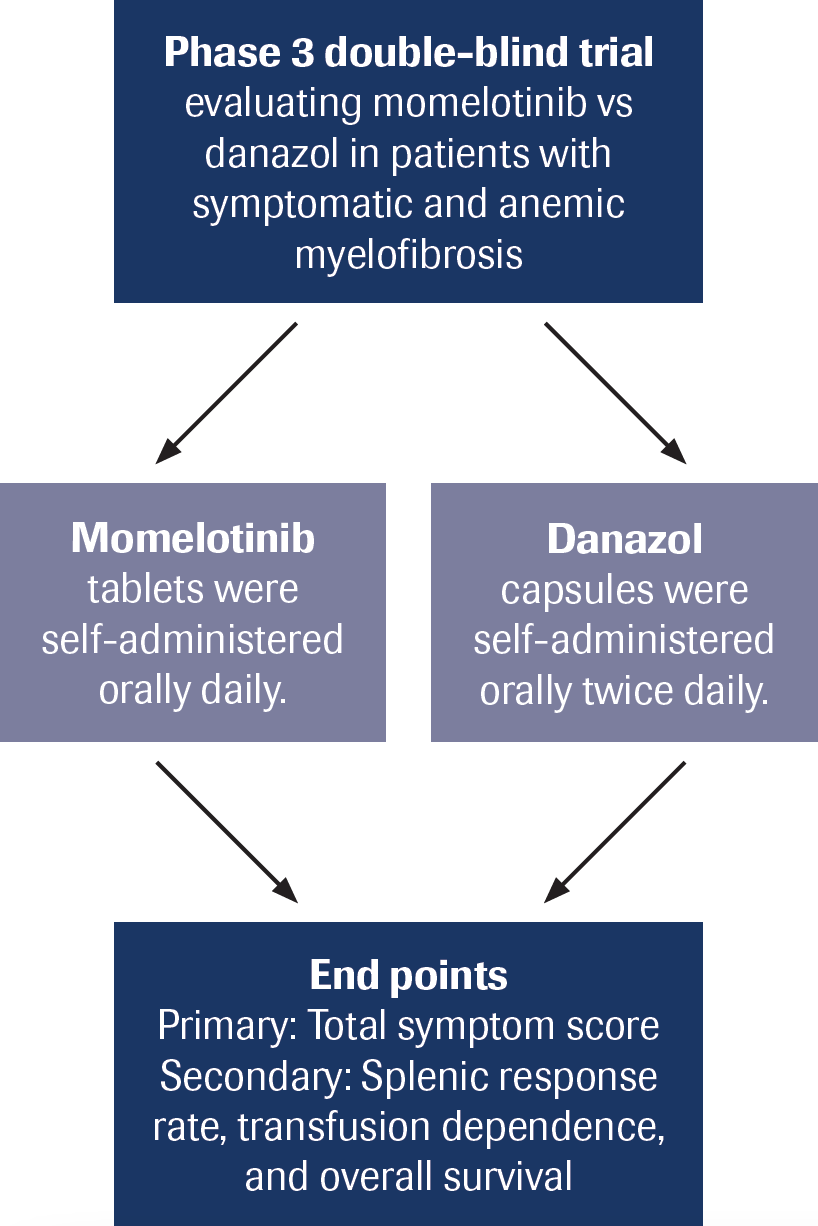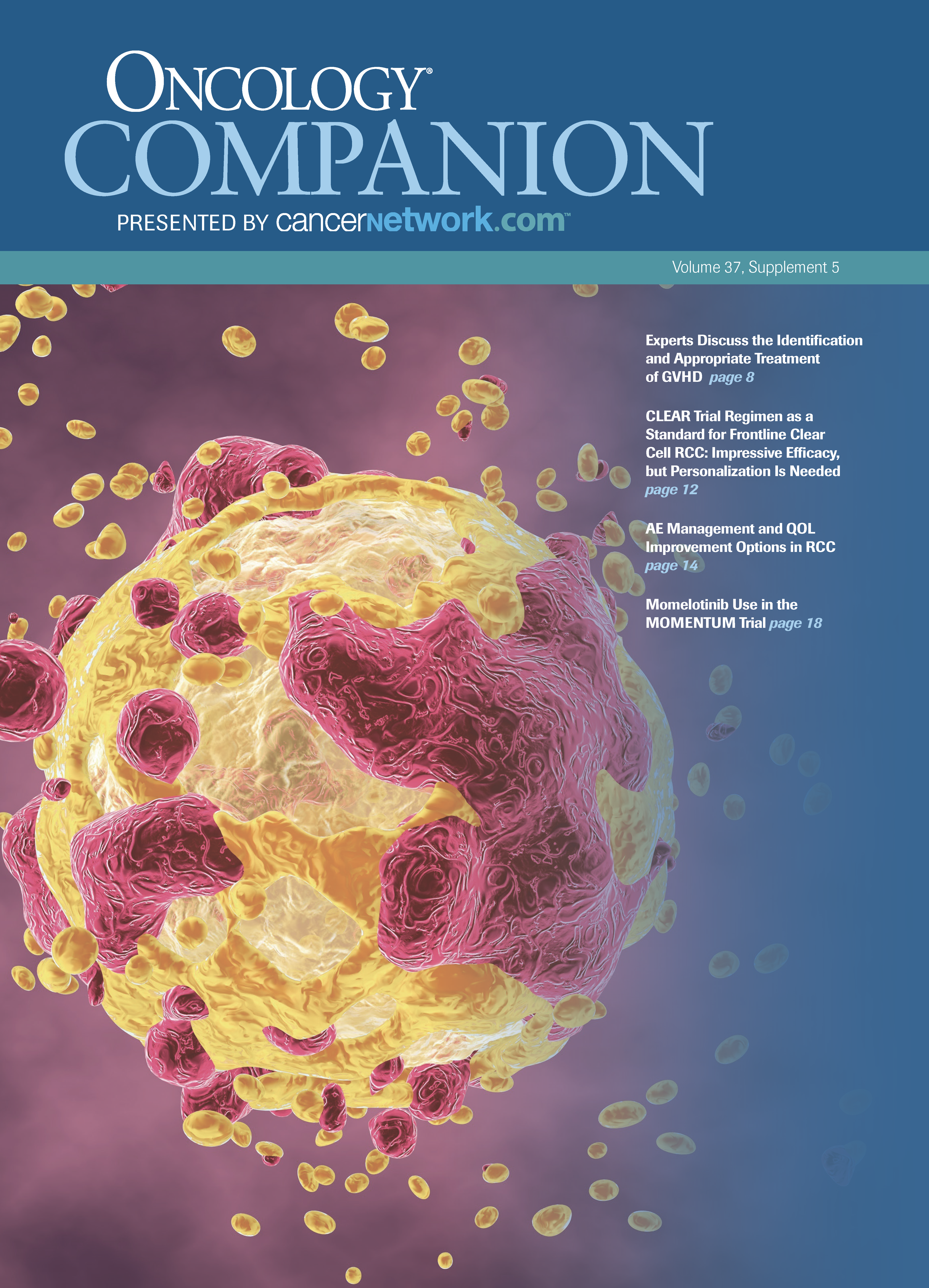Momelotinib Use in the MOMENTUM Trial
Lead study author Ruben Mesa, MD, discusses findings from the MOMENTUM trial assessing the use of momelotinib in the treatment of myelofibrosis.


Q: What were the results of the MOMENTUM trial?
MESA: The phase 3 MOMENTUM study (NCT04173494) built on prior experiences from momelotinib that had shown improved splenomegaly symptoms and anemia in patients with myelofibrosis, likely [because of] inhibiting JAK2 but also inhibiting ACVR1, decreasing hepcidin, and improving the process of erythropoiesis.1 This was a double-blind, randomized [trial] between momelotinib and danazol for patients who had [experienced failure with a] JAK inhibitor, such as ruxolitinib [Jakafi], needed therapy, and were anemic.
Patients were [randomly assigned] 2:1 [to] momelotinib [or] danazol. The study hit all its primary end points, and momelotinib was clearly superior for improvements in splenomegaly symptoms. We had built into the analysis that it would be noninferior for improvement in anemia, with danazol being probably the only available agent that has real activity in anemia for patients with myelofibrosis. It nearly achieved superiority. The numbers were clearly better for momelotinib but didn’t quite achieve superiority, although we had not built that in as an expectation. We viewed it as a very successful outcome to the study of a real viable therapy in the second-line [setting,] improving spleen symptoms and anemia better than the standard of care. Danazol is a reasonable standard of care, and there is no approved therapy in that group. [The MOMENTUM study] builds on prior experiences with momelotinib, which had shown clear activity in the front-line and second-line settings in the phase 3 Simplify 1 [NCT01969838] and phase 3 Simplify 2 [NCT02101268] studies.
How will the use of momelotinib in this population improve quality of life?
MESA: I think it’ll improve it on multiple levels. There is the benefit of being a JAK inhibitor in terms of the whole constellation of symptoms associated with cytokines, such as night sweats, fevers, bone pain, and weight loss. [Momelotinib has the] ability to improve splenomegaly, the early satiety, the discomfort, the pain. All of that comes with [momelotinib treatment], and that’s all part of the JAK inhibitor group. Where it’s incremental is that it also helps to improve anemia. There was improved oxygen-carrying capacity [due to] less anemia, which means better ability to do the activities of daily living, the activities that people want to do, like go out with friends and be active. There is an incremental benefit over some of the other JAK inhibition that we’ve had because it brings in that piece.
If momelotinib is approved by the FDA, how will it impact the standard of care?
MESA: I think it will make an immediate impact. There clearly are individuals now who are on the JAK inhibitors ruxolitinib or fedratinib [Inrebic] who have significant anemia and will immediately be potential candidates. We’ll see how the National Comprehensive Cancer Network guidelines form, but there’s a case to be made for consideration as the initial JAK inhibitor is selected for [patients who] have significant anemia. We’ll see what the label is. There will be an overlap for a segment of patients or candidates for pacritinib [Vonjo]. Individuals with a platelet count of less than 25 mL who have only been tested with pacritinib [and had a platelet count of] 25 mL to 50 mL were also included in this trial. One might have a case for either agent. There will be more clear candidates for momelotinib as the primary agent.
Are there any adverse effects (AEs) clinicians should be aware of?
MESA: It was a well-tolerated drug in addition to the usual adverse effects we see with JAK inhibitors. One needs to monitor for anemia and thrombocytopenia. Again, [momelotinib] can improve anemia, but like all these things, that’s not universal. One needs to still monitor for that toxicity, and that’s universal across the JAK inhibitors. In terms of grade 3/4 [AEs], we had very few toxicities, but in terms of grade 1/2 gastrointestinal-related toxicities, the most common was diarrhea, seen at any grade in 22% of patients. No [AEs were reported] over grade 3; [it’s] rare for [AEs] to be severe, but it can happen. There was a little bit of nausea in 16% of patients. Again, grade 1/2. In earlier studies of momelotinib, there had been issues with a little bit of neuropathy, but that wasn’t seen in the MOMENTUM study to any significant degree.
What are some unmet needs in myelofibrosis?
MESA: The agents that we have clearly make an impact. Momelotinib clearly extends that further with the improvement of spleen symptoms and anemia, where we have the core base of ruxolitinib, fedratinib, pacritinib, and momelotinib. The combination approaches are going to be very impactful in what we hope to gain with combinations of pelabresib, parsaclisib, navitoclax, and others in development. These might be either greater depth of response or more evidence of “disease modification.” We don’t truly know how to frame that. In my mind, patients can live longer or better.
Another unmet need is for individuals with very advanced diseases, moving toward acute leukemia. That’s a slightly different biology, with more mutationally driven, more severe cytopenias, more overlap potentially with therapies in the acute leukemia space. Whether there’ll be targeted agents such as IDH1, IDH2 inhibitors, or venetoclax [Venclexta], or other acute leukemia therapies in development, that remains a very difficult group of patients to treat and [we still] do not have a good answer.
REFERENCE
- Mesa RA, Gerds AT, Vannucchi A, et al. MOMENTUM: phase 3 randomized study of momelotinib (MMB) versus danazol (DAN) in symptomatic and anemic myelofibrosis (MF) patients previously treated with a JAK inhibitor. J Clin Oncol. 2022; 40(suppl 16):7002. doi:10.1200/ JCO.2022.40.16_suppl.7002
Newsletter
Stay up to date on recent advances in the multidisciplinary approach to cancer.
